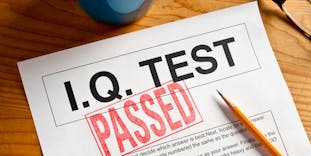How and Where to Take Stanford-Binet IQ Test
- What Is the Stanford-Binet IQ Test?
- What Is The Stanford-Binet IQ Test Used For?
- What Is Included in the Stanford-Binet IQ Test?
empty
empty
empty
empty
empty
- How Is the Stanford-Binet IQ Test Scored?
- What Score Do You Need to Pass the Stanford-Binet IQ Test?
- What Is the Average Score of the Stanford-Binet IQ Test?
- How to Practice for the Stanford-Binet IQ Test in 2024
- Frequently Asked Questions
- Final Thoughts
The Stanford-Binet test is an IQ test or intelligence test used to examine people's intelligence and cognitive function.
This could be administered to young children adolescents of chronological age by an educational establishment (looking at whether a child might have learning disabilities or cognitive function issues), or as part of the hiring process for a specific job role.
Some hiring managers might want to ensure they are considering the right candidates before a face-to-face interview.
The Stanford-Binet IQ test assesses different levels of intelligence and cognitive abilities, from numerical reasoning to verbal and spatial awareness.
What Is the Stanford-Binet IQ Test?
The Stanford-Binet intelligence scale was first launched in 1916 as the successor to the Binet-Simon scale formed in 1905 (the first IQ test used to distinguish a person's intelligence), which was created by Alfred Binet.
It was designed to assess a child's intellectual ability and cognitive function.
Sometimes it was even used in the medical field to test for neurological disorders, for example, if a person had suffered a trauma or might have a neurological disorder.
Sometimes this type of test is used for children attending a private school or a specially gifted school.
Each test is divided into 10 subtests, which we'll examine in more detail later in this article.
Once completed, each test is compared against the national average test score.
What Is The Stanford-Binet IQ Test Used For?
The Stanford-Binet IQ test is used for several reasons.
It is mainly used to gauge the mental age, cognitive function and overall intelligence of younger people.
It can help parents and educators gain an understanding of how the child is developing and what skills they might be lacking for their age group.It can also provide their IQ score and analyse their working memory.
The test can also measure certain skills in adults, especially if they are applying for a role that demands those skills.
If you are wondering about possible gaps in your education and in what areas you might need to gain more skills, the test may help.
It can provide the candidate with an opportunity to understand how their weaknesses might play a vital role in their everyday life that they might not have realized before.
You may want to take the Stanford-Binet test as part of your career journey or just to get an idea of your own intelligence for self-improvement and further knowledge of your skillset.
If you want to take it for your personal reference, contact a psychologist or educational institute. There are also practice tests you can take online.
The full version of the exam needs to be administered by a professional. Some schools and clinics might also be able to help you take the test.
What Is Included in the Stanford-Binet IQ Test?
The test looks into five different cognitive functions and ten subsections. You can expect to see both verbal and non-verbal questions.
The test can take anywhere from 45 minutes to three hours. This is dependent on the individual completing the assessment.
Some people might have more subtests than others. This could be because they are older or just because further assessment is needed.
The five areas mentioned below will be measured in different ways.
For example, the quantitative reasoning test will look at both verbal and non-verbal numerical patterns, and the memory segment looks at memory lapses and responses.
The reason that these subtests were initiated in the first place is due to educational regulations changing in the early 1900s. The test has been altered a few times since its inception.
The five different measures are:
Stanford-Binet IQ Memory
This will probably be the child's first memory test, and measures their short-term memory.
They might be asked to remember a picture they have just been shown, and their response may be timed.
It will also show whether extra work is needed to help the person retain information.
Stanford-Binet IQ Knowledge
This is a test of general knowledge, and tests both memory and the knowledge they have picked up over the years.
The candidate is presented with scenarios that they will need to discuss.
This part of the exam also evaluates areas such as vocabulary, knowledge of procedures and image variations.
Stanford-Binet IQ Quantitative Reasoning
This is designed to examine someone's number skills. Each section of the test can include the basics of addition, subtraction and more.
For higher-level examinations, you might be measured on your geometry too.
Stanford-Binet IQ Visual-Spatial Processing
For visual-spatial processing, you will be asked to recognize patterns and relationships between puzzles.
It is a non-verbal section of the complete Stanford-Binet examination that will measure the person's visual skills and memory.
Stanford-Binet IQ Fluid Reasoning
In this section, the person taking the test will need to solve a problem without any previous knowledge of learned information.
The person being assessed might see a series of objects or patterns and be asked to complete the pattern based on what they have seen.

How Is the Stanford-Binet IQ Test Scored?
You might wonder how the Stanford-Binet test is scored and calculated, especially if there are five different formats to measure.
What Score Do You Need to Pass the Stanford-Binet IQ Test?
The pass score depends on the candidate, for example, their age. Older people may need to achieve a higher score.
What Is the Average Score of the Stanford-Binet IQ Test?
According to statistics, the average score for the Stanford-Binet test is 100.
Here are the following scores you might expect to see at the end of an exam and what they mean regarding a person's intelligence.
- 145–160+ – Highly gifted
- 130–144 – Moderately gifted
- 120–129 – High achiever
- 110–119 – High average
- 90–109 – Average
- 80–89 – Low average
- 70–79 – Borderline impaired or delayed
- 55–69 – Mildly impaired or delayed
- 40–54 – Delayed or moderately impaired
These scores will be compared to other tests taken within the individuals' age group, and helps to determine averages for different ages.
The test has been studied by researchers and is considered a reliable source of information. The most recent iteration of the test has proven to be highly precise.
How to Practice for the Stanford-Binet IQ Test in 2024
How you practice for the examination can depend on how and why you are taking the test to begin with.
For example, younger candidates at school level might not have the option to prep for the test beforehand as they are being assessed on their intelligence at that age.
However, if you are a parent whose child is taking the test, there are a few ways you might be able to get them ready, especially if you know they are about to take the exam.
Step 1. Turn It Into a Game
Play games that help them to practice sitting still for a certain amount of time, so they will be prepared for the testing environment.
Step 2. Help With Their Memory
Play games with them to keep their mind fresh and energized before the exam. Showing them pictures of their favorite things and asking them to recite the objects can help to stimulate the brain.
Step 3. Do Jigsaw Puzzles
Puzzles are a great way to keep your child entertained whilst learning how to be relaxed and interested. It also helps them problem-solve by finding the right piece for the section. This can help with visual and spatial awareness.
Step 4. Do Prep Tests
There are questions online that may be presented in the Stanford-Binet test. Keep your child entertained by explaining this is just a quiz and that they could win a prize at the end.
Step 5. Keep Them Relaxed
Before test day, it is imperative that you keep them relaxed and ensure they have plenty of sleep the night before.
This will ensure that they are well rested and mentally prepared for the day.
If they are tired, it might not help them to sit still for a long period of time, and they might also get anxious.
Step 6. Explain What the Test Is
Try to give them as much information as you can in an easy-to-understand way that will ensure they are happy with taking the test. After all, knowledge is power. If they are an older child, they might appreciate being kept in the loop.
If you are an adult taking the test for work, you might want also want to follow some of the advice listed above.
When taking practice tests online, do it at a time when you feel relaxed, to help you get the most out of your practice session and give you confidence for the day.
You might also want to investigate the test further and do the questions in a different order, as the test will probably not be formatted in the same way as the practice tests.
Frequently Asked Questions
Licensed psychologists or trained professionals administer the Stanford-Binet test. It is not a self-administered test. Individuals interested in taking the test should contact a licensed psychologist or a qualified testing professional.
The duration of the Stanford-Binet test can vary based on the specific version and the individual being assessed. Generally, the test can take several hours to complete.
The Stanford-Binet test is typically administered by licensed psychologists, educational diagnosticians, or professionals trained in psychological testing. It is often conducted in a clinical or educational setting.
No, the Stanford-Binet test is not free. It is a comprehensive IQ test administered by professionals, and a fee is usually associated with it.
The Stanford-Binet Intelligence Scales and the Wechsler Intelligence Scales are widely used IQ tests but differ in their methodologies and scoring systems. The Stanford-Binet tends to have a longer history, while the Wechsler scales are known for their flexibility and separate assessments for verbal and non-verbal abilities.
The Stanford-Binet test is designed for individuals of all ages, including children. There are specific versions tailored to different age groups. Children as young as two years old may be assessed using appropriate test adaptations. The choice of version depends on the child's age and developmental stage.
Final Thoughts
If you have decided that you want to take the Stanford-Binet test yourself or you want to arrange an examination for your child, there is nothing to worry about.
It is a straightforward assessment that is administered by educational professionals and neurological doctors.
Just contact your local authority or check online to see where you, or your child, can take the test locally.
The main aim of the test is to assess an individual's cognitive functions and overall intelligence. The scores for the test, as mentioned above, are quite straightforward to understand.
If you are unsure about what the results mean, please contact a professional or the person who administered the test.
And as for prep? Well, the tools and tricks suggested in this article should help you or your child be fully prepared for the test.






